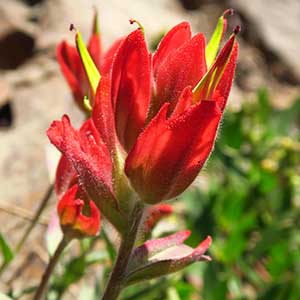Castilleja montigena
Castilleja elmeri
Heckard's Indian paintbrush, Heckard's paintbrush
Elmer's Indian paintbrush, Elmer's paintbrush, Wenatchee Indian paintbrush, Wenatchee paintbrush
few to several, decumbent to erect, sometimes leaning, unbranched or often much-branched distally, with a few short, leafy axillary shoots, hairs spreading, short, soft, stipitate-glandular, mixed with long-spreading, eglandular ones.
solitary or few to many, erect to ascending, sometimes slightly curved at base, unbranched, rarely branched, hairs moderately dense, spreading, medium length, soft, mixed with shorter eglandular and stipitate-glandular ones, at least on distal 1/2 of stem.
gray-green, sometimes green, lanceolate-linear to narrowly lanceolate, 1–6.5 cm, not fleshy, margins plane, sometimes wavy, flat to involute, 0(–3)-lobed, apex acuminate;
lobes spreading-ascending, linear to narrowly lanceolate, apex acute.
green, rarely purple-tinged, linear-lanceolate, sometimes linear or lanceolate, 1.3–6.5 cm, not fleshy, margins plane, flat or involute, entire, apex acute.
3–30 × 3–4 cm;
bracts proximally green to dark purplish, distally red to crimson, sometimes pale salmon, linear-lanceolate to broadly lanceolate, 3–5-lobed;
lobes spreading, linear, long, arising below mid length, apex acute, sometimes obtuse.
2.5–9 × 1.5–3 cm;
bracts red, crimson, scarlet, pink, magenta, red-orange, burnt orange, orange, pale yellow, or whitish throughout, or proximally greenish, distally as stated above, oblong, narrowly obovate, elliptic-oblong, or narrowly ovate, 0(–5)-lobed, rarely with 1 or 2 pairs of short, usually distal lobes;
lobes ascending, lanceolate, very short, arising from distal edge, apex rounded to obtuse.
0 mm.
straight or slightly curved, 20–40 mm;
tube 15–23 mm;
abaxial lip exserted to included, beak much exserted;
beak adaxially yellow-green to reddish, 9–18 mm;
abaxial lip green, reduced, 0.5–1.5 mm, 5–20% as long as beak;
teeth incurved, green, (0–)0.5–1.5 mm.
straight, 20–33 mm;
tubes 13–18 mm;
beak, and sometimes abaxial lip, partially to fully exserted;
beak adaxially green to yellowish, 8–15 mm;
abaxial lip incurved, green, thickened, 2–3 mm, 20–33% as long as beak;
teeth ascending or incurved, green, 0.5–1 mm.
colored as bracts, 15–20 mm;
abaxial clefts 3.4–6.2 mm, adaxial 4.5–9 mm, clefts 25–33% of calyx length, deeper than laterals, lateral 0.5–2 mm, 5–10% of calyx length;
lobes narrowly triangular, often slightly unequal, apex acute.
proximally green to pale green, distally colored as bracts, 15–25 mm;
abaxial and adaxial clefts 5–14 mm, 33–50% of calyx length, deeper than laterals, lateral 1–4 mm, 6–20% of calyx length;
lobes lanceolate to narrowly triangular, apex rounded to obtuse.
= 48, 72.
= 48.
Castilleja montigena
Castilleja elmeri
Castilleja montigena is endemic to the northeastern portion of the San Bernardino Mountains of southern California. In the field, this species is consistently and relatively easily distinguished from nearby populations of C. martini var. martini, which it essentially replaces in the northeastern portion of the San Bernardino Mountains. It is apparently of allopolyploid hybrid origin between C. martini var. martini and C. chromosa, which approaches its range from the adjacent Mojave Desert.
(Discussion copyrighted by Flora of North America; reprinted with permission.)
The bracts and inflorescences of Castilleja elmeri can be red, crimson, scarlet, pink, magenta, red-orange, burnt orange, orange, pale yellow, or whitish. While the coloration is highly variable between local populations, it is usually uniform and consistent within them. It is found primarily in the Wenatchee Mountains of Washington, where it is often on serpentine, but it ranges northward in the Cascades into extreme southern British Columbia, apparently on non-serpentine substrates. Hybrids with C. miniata var. miniata, C. parviflora var. albida, and C. thompsonii have been found in the eastern Cascades of Washington, and a similar hybrid swarm with C. thompsonii is reported from southern British Columbia.
(Discussion copyrighted by Flora of North America; reprinted with permission.)


